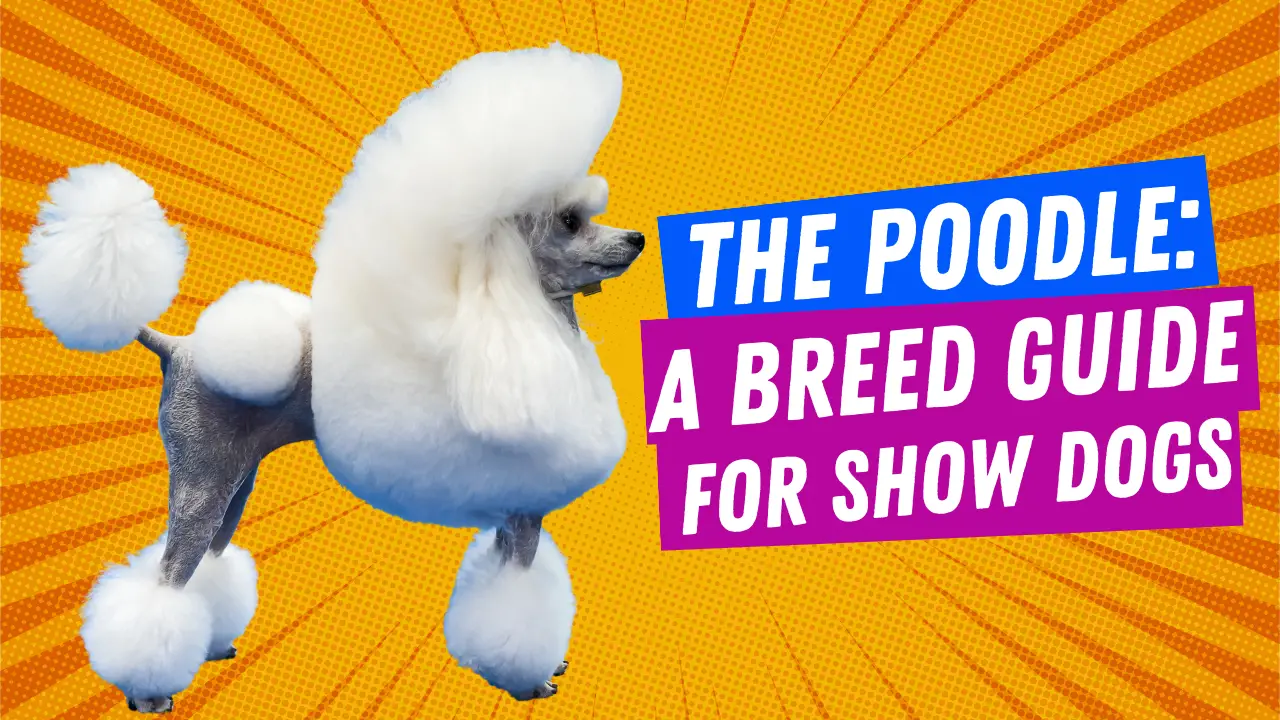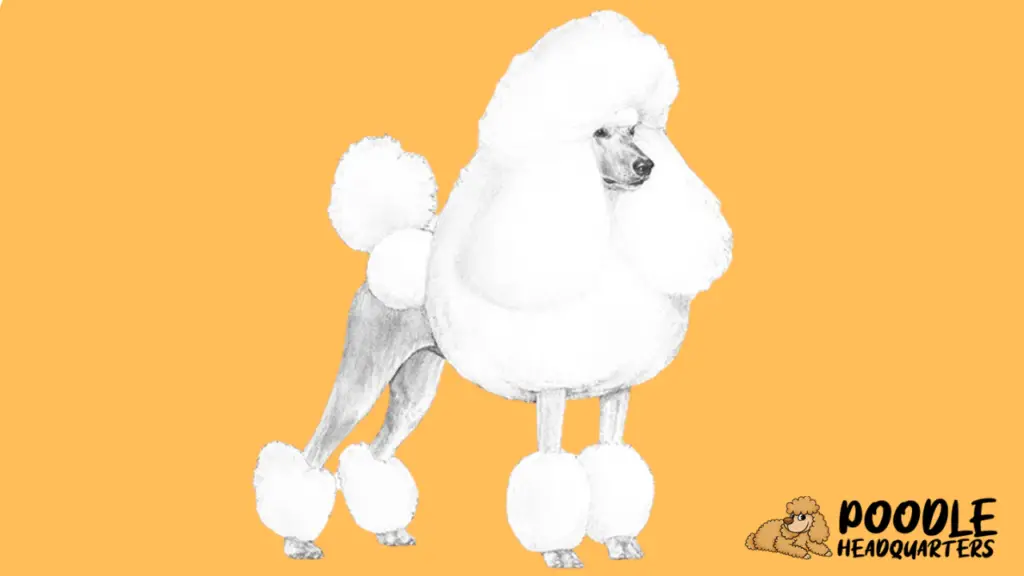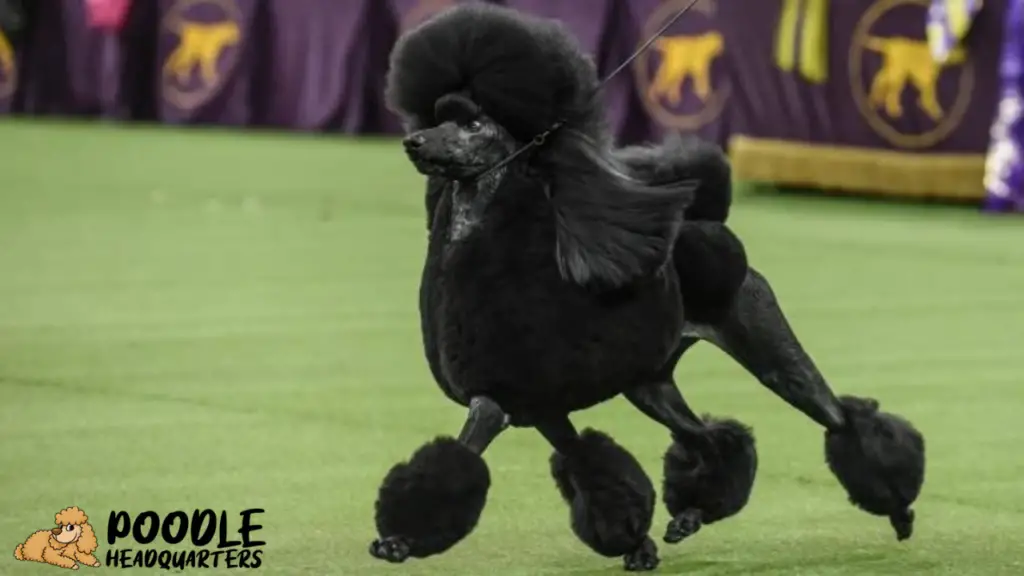The breed standard for Poodles is a written description of the ideal physical and temperament traits of the breed as determined by breeders and judges. While there may never be a “perfect” Poodle, breeders use the standard as a set of goals to strive for, and judges use it to evaluate how well breeders are achieving these goals. In the show ring, Poodles are compared to the breed standard and the dog that most closely conforms to it is considered the best. The following description is taken from the American Kennel Club (AKC) breed standard. Those interested in showing their Poodle should familiarize themselves with all of the details, faults, and disqualifications listed in the complete standard.

What Will You Learn? 👇
General Appearance
When defining the breed standard, if you’re like me, you’ll know the appearance of a Poodle plays an important role. Generally, a Poodle should look quite elegant with a well proportioned square build allowing them to carry themselves with pride. Alongside this, they should have a distinctive curly coat that can be corded or curled.
Size
When it comes to the size of the Poodle, there’s no set size for them to be; however, they must fall within certain ranges, which are:

Read our Smart Poodles - Smart Tricks eBook for only $2.99
Dive into a treasure trove of engaging tricks and tips designed specifically for your poodle!
| Type | Height (At shoulders) |
| Toy Poodle | Over 15 inches |
| Miniature Poodle | 15 inches or under |
| Standard Poodle | 10 inches or under |
Proportion
When it comes to your Poodle their body must have a specific proportion for it to fall into the breed standard requirements set by the AKC. The proportion requirements are the same for all the Toy, Miniature and standard. All three dogs must have a square build and abide to certain lengths. For instance, the height from the top of their shoulders to the ground should be the same length as the distance between their breast bonebone and rump.
Substance
When standing, the bone and muscles from their front and hind legs should be in proportion. You can check this by measuring their elbows to the ground.
Head and expression
Another thing to check for is the facial features a Poodle has, its size, and its expression.
- Eyes: Should be oval in shape and dark in color. Some of their colors can range from amber to brown with dark black points. Their positioning should be far apart and just enough to create bright and intelligent expressions.
- Ears: Their ears should be just below their eye level drooping next to their head. The typical texture of their ears should be feathered, wide, and long.
- Skull: Their skull should be rounded with flat muscles and cheekbones.
- Muzzle: A long, straight, and fine muzzle.
Note: The Poodle should have a scissor bite showing its strong teeth.
Neck, topline, and body
The Poodle’s neck should be evenly proportioned, long, and strong enough for them to hold its head high with dignity. Their neck should strongly rise up from their smooth square shoulders. Similarly, their topline should be even, not looking sloped or hunched. However, if there is a slight dip behind their shoulder, this is ok. Yet if their shoulders are steep, this is not appropriate for the Poodle.

Forequarters
If you look at a Poodle from the front, then their forelegs should be parallel and straight when looking at them. Their elbow should be just below their shoulder’s highest point and declaws should be removed.
Feet
When you pay attention to their feet, they should be tight, have an oval shape and face straight. Their feet should never be turned in or out, and their toes should be arched on thick, firm, cushioned pads. Moreover, their feet should have strong pasterns on them.
Major fault: A Poodle should not have flat feet, also known as paper feet. Similarly, they must not have splayed feet. This condition occurs when there is a significant gap between their toes and can be caused by either biological or environmental factors.
Hindquarters
Another vital factor to consider is the angle of your Poodles hindquarters. To fall properly within the breed Standard, they should balance them with their forequarters.

Just like their forequarters, they should be straight and parallel when you look at them from behind. Similarly, their muscles should be well bent. In particular, their femur and tibia bones should be equal in length. Their hock joint situated on their back leg below their knee should be perpendicular to their heel.
Coat & Clips
If you’re interested in taking your Poodle into the show ring, then your Poodle needs to have the right coat quality and clippings. If they don’t align with the specific guidelines mentioned by the AKC, they will fail to qualify for the Breed Standard.
Quality
The quality of a Poodles coat must be curly, with a naturally tough texture, and should be dense throughout the body. If not curly, it should be corded where their hair hangs in even and tight cords that can vary in length. However, their coat chords must be longer on their mane, body, head, and ears. Similarly, they should be shorter on their bracelets, pompoms, or puffs.
Clip
For show purposes, if your Poodle is younger than 12 months, then they can sport the puppy clip. Whereas if they are over 12 months old and attend regular classes, they must either have an English Saddle or Continental Clip. If your Poodle has any other form of clip-on competition, then they will be disqualified from the show ring.
Puppy Clip
This type of clip is where their coat is long, and their throat, face, feet, and base of the tail are shaven. Their feet should also be shaved and easy to see. Moreover, their tail should be cut into a pompon to make their appearance look neat. Similarly, when looking at the line of the Poodles coat, it should be smooth and unbroken.
English Saddle Clip
For your Poodle to have this clip, their throat, feet, face, forelegs, and tail base should be shaved. It’s important to note that their legs should not be fully shaved; there should be puffs of fur left on their forelegs and a pompon on the top of their tail.
Similarly, there should be a short blanket of hair on their hindquarters apart from a shaved part of their body that connects to the upper part of their leg and two shaved parts on their back legs. Similarly, there should be a visible area of their shaved leg above the puff. Also, the rest of their coat should be full and can be shaped if needed to make sure their body looks balanced and proportionate.
Continental Clip
This clip is when a Poodle’s tail, feet, throat, and base should be shaved. They can have optional pom poms on their hips. However, they must have puffs of hair on their forelegs, bracelets on their hind legs, and a pompom on their tail. In the same way, they should have some fur above their legs and feet that have been shaved.
Sporting Clip
For the Poodle to have a sporting clip their tail base, feet, throat, and face should be shaved. Moreover, their body and legs should be scissored and clipped to follow the coat’s outline, where their coat should be no longer than one inch long. Similarly, the hair on their legs may be slightly longer than their body.
In either of the three clips, the topknot hair can either be free or kept in place using elastic bands. If you’re unfamiliar with the topknot, it’s the hair on the skull where its bony counterpart (occiput) occurs. This is the only area where you can use elastic bands.
To ensure your Poodles coat and clip fall within the breed standards, you should take it to a professional groomer. Professional groomers are equipped with the right knowledge and expertise to give your Poodle either a Puppy, English Saddle, or Sporting Clip.
Colors
The coat of your Poodle should be even and have a solid color on its skin. For them to fall into the category of a breed standard, their coat must be silver, brown, gray, blue, apricot, cream of café-au-laits, apricots, and creams. It is possible for their coat to show different shades of the same color.
When it comes to brown and café-au-lait coats, Poodles must have a liver colored nose, lips, eye rims, dark amber eyes, and toenails. Similarly, blue, black, silver, gray, white, and cream coats should have black noses, lips, eye rims, and toenails. In contrast, apricot Poodles should have liver-colored noses, rim, and lips.
Major note: If their coat is particolored, they won’t be classed as a breed standard.
Gait

The gait of a Poodle must be light and springy with a straightforward trot. Their power must come from their hindquarters, with their head and tail held high. When they walk, there should be no sound, and it should look effortless.
Temperament
Poodles should carry themselves with pride and showcase their intelligence when required. To meet the AKC’s breed standard, they should be active and participate in the exercise.
Major Fault: If they’re shy or sharp with humans, then they will not fall into the AKC’s characteristics.
Conclusion
Now that you have a better understanding of the breed standard, why not put your newfound knowledge to the test? Consider entering your Poodle into a show or joining a club to connect with other Poodle owners and breeders. No matter your goals, there are plenty of ways to get involved with the Poodle breed and continue learning about these intelligent dogs.
Marko is the founder and author at PoodleHQ, where he blends profound expertise with formal training in Animal Behavior and Canine Genetics. With multiple generations of poodles under his care, he’s a breed connoisseur, honored with the Canine Care Excellence Award and lauded by the International Pet Enthusiasts Association.

